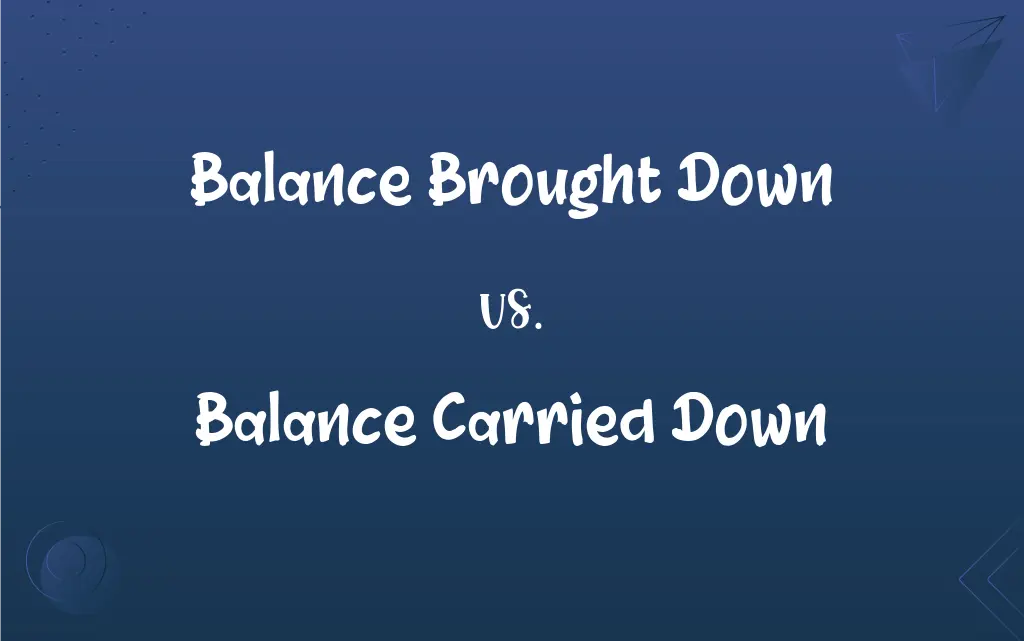Balance Brought Down vs. Balance Carried Down: What's the Difference?
Edited by Aimie Carlson || By Harlon Moss || Published on December 11, 2023
Both terms refer to the same concept in accounting - the balance from a previous period brought forward to the current one.

Key Differences
Both "balance brought down" and "balance carried down" are accounting terms used interchangeably. They refer to the process of transferring a balance from one accounting period to the next.
In financial accounting, "balance brought down" is often seen at the beginning of a new accounting period, indicating the opening balance. "Balance carried down" is used at the end of an accounting period, signifying the closing balance to be carried forward.
Both terms are crucial in double-entry bookkeeping, ensuring continuity and accuracy in financial records. They ensure that the balance from one period is accurately reflected in the subsequent period.
These terms are applicable in various accounts, such as assets, liabilities, equity, revenue, and expenses. They help in tracking the flow of funds and financial position over different periods.
For stakeholders like investors and managers, understanding these terms is essential for analyzing financial health and trends over time. They indicate the continuity of financial data, which is crucial for decision-making.
ADVERTISEMENT
Comparison Chart
Usage in Time
Used at the beginning of an accounting period.
Used at the end of an accounting period.
Purpose
Indicates the opening balance.
Signifies the closing balance.
Bookkeeping Role
Ensures continuity of records into the new period.
Reflects the completion of the current period's records.
Account Types
Applicable across various account types.
Similarly applicable across different accounts.
Stakeholder Relevance
Essential for understanding the start of a new period's finances.
Crucial for analyzing the end-period financial status.
ADVERTISEMENT
Balance Brought Down and Balance Carried Down Definitions
Balance Brought Down
Transferred Balance.
This balance brought down represents last month's closing amount.
Balance Carried Down
Completion of Current Period.
The balance carried down marks the completion of this period's accounts.
Balance Brought Down
Opening Balance.
The balance brought down was $5,000 at the start of the month.
Balance Carried Down
Preparation for Next Period.
We prepared for May by carrying down a balance of $3,000.
Balance Brought Down
Continuity in Accounting.
The balance brought down ensures continuity from the previous period.
Balance Carried Down
Ending Ledger Entry.
The ledger concluded with the balance carried down.
Balance Brought Down
Starting Point for New Period.
The new accounting period started with a balance brought down of $10,000.
Balance Carried Down
Transferred to Next Period.
This balance carried down will appear in next month's books.
Balance Brought Down
Beginning Ledger Entry.
In the ledger, the balance brought down is recorded first.
Balance Carried Down
Closing Balance.
The balance carried down at the end of April was $4,500.
FAQs
Where is 'balance brought down' recorded?
It's recorded at the beginning of a new accounting period in the ledger.
How is 'balance carried down' used?
It is used to denote the closing balance of an account at the end of an accounting period.
Are these terms interchangeable?
Yes, 'balance brought down' and 'balance carried down' are often used interchangeably in accounting.
What does 'balance carried down' indicate?
It indicates the balance that will be carried forward to the next period as the opening balance.
Can 'balance brought down' be negative?
Yes, if the previous period ended with a negative balance.
What is 'balance brought down'?
It's the opening balance of an account brought from the previous accounting period into the new one.
Why is 'balance carried down' important?
It's important for ensuring the continuity and accuracy of financial records across periods.
How does 'balance brought down' affect financial analysis?
It provides a starting point for analyzing financial activities in a new period.
What role do these terms play in double-entry bookkeeping?
They ensure each account begins and ends with the correct balances, maintaining the integrity of double-entry bookkeeping.
Is 'balance brought down' an asset or liability?
It can be either, depending on the nature of the account it refers to.
Does 'balance carried down' appear in financial statements?
It typically appears in internal ledgers rather than external financial statements.
Can these terms be used for all types of accounts?
Yes, they are applicable to various account types like assets, liabilities, and equity.
Can 'balance carried down' be adjusted?
Adjustments are usually made before carrying down the balance to reflect accurate and final figures.
How often is 'balance carried down' calculated?
It's calculated at the end of each accounting period, whether monthly, quarterly, or annually.
What does a large 'balance brought down' indicate?
It may indicate significant carried-over assets or liabilities from the previous period.
Do 'balance brought down' and 'balance carried down' have different implications for investors?
Investors look at these figures to understand financial continuity and the starting point for new financial analyses.
What happens if there's no 'balance carried down'?
If there's no balance to carry down, it implies the account was settled or balanced at period end.
Is it necessary to have a 'balance brought down' in every account?
It's necessary if the account had an active balance at the end of the previous period.
Should 'balance carried down' match the opening balance of the next period?
Yes, the 'balance carried down' should match the 'balance brought down' of the subsequent period for accuracy.
Are these terms used in cash flow statements?
They are primarily used in ledgers and balance sheets, rather than cash flow statements.
About Author
Written by
Harlon MossHarlon is a seasoned quality moderator and accomplished content writer for Difference Wiki. An alumnus of the prestigious University of California, he earned his degree in Computer Science. Leveraging his academic background, Harlon brings a meticulous and informed perspective to his work, ensuring content accuracy and excellence.
Edited by
Aimie CarlsonAimie Carlson, holding a master's degree in English literature, is a fervent English language enthusiast. She lends her writing talents to Difference Wiki, a prominent website that specializes in comparisons, offering readers insightful analyses that both captivate and inform.
































































